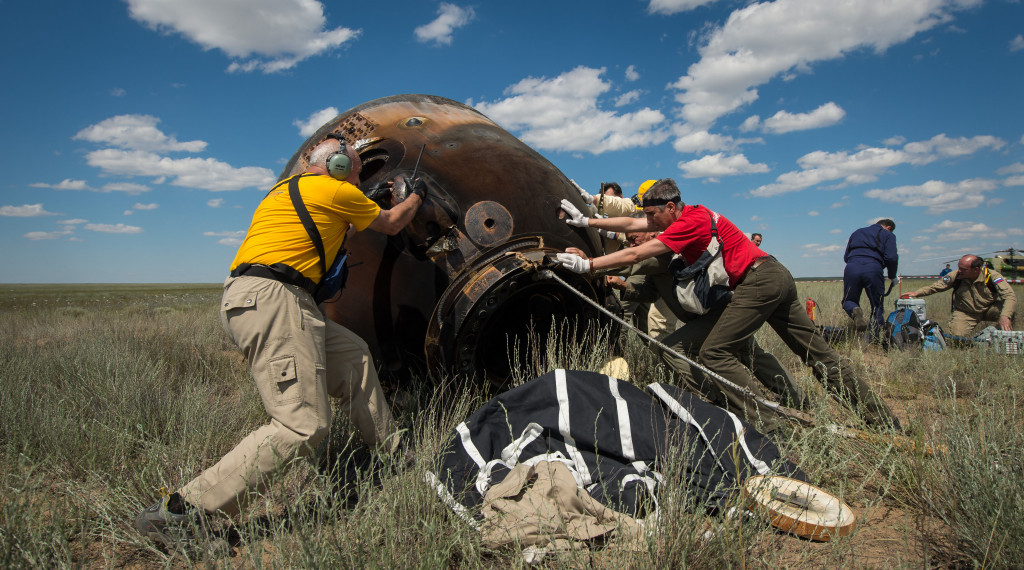Soyuz TMA-19M spacecraft is the first flown, human-rated spacecraft to be acquired by the United Kingdom, and today (5 December 2016) joins the Science Museum Group’s space technologies collection.

This spacecraft carries a lot of statistics and superlatives.
It’s been in space, attached to the International Space Station (ISS) and orbiting the Earth, for six months.
By my reckoning that means it’s clocked about 74,000,000 miles. That’s about 400,000 miles each day. To get into orbit its rocket had to accelerate it to 17,200 mph, the same speed it was travelling at when it started its eventual return to Earth. As it plunged through the atmosphere its surface heated to 1500 degrees C.
You can see the scorching and charring on its surface.
But it also carries a human story; this is the actual spacecraft that took astronauts Yuri Malenchenko, Tim Kopra and Britain’s Tim Peake up to the ISS in 2015 and then returned them safely to the Earth the following year. It was Peake’s first spaceflight, Kopra’s 2nd and Yuri Malenchenko’s 5th. It was the first time two ‘Tims’ had shared a space mission!
Malenchenko, spacecraft commander, brought all of his experience to bear when the craft’s automatic docking system failed on approach to the Station; he took manual control and docked the Soyuz safely. During its return to Earth the spacecraft bucked and tumbled and spun – pretty much like every Soyuz descent; the very best of training couldn’t forewarn Tim Peake of some of the bumps and he glanced for reassurance to his veteran crew mates.
Spaceflight is extremely dangerous; the first manned Soyuz mission ended in tragedy when it crashed to Earth killing cosmonaut Vladimir Komarov. But Soyuz is now a stalwart of human spaceflight.
It was designed in the early 1960s as a three-person replacement to the single seater Vostok. Soyuz (‘union’ in Russian), unlike its predecessor, would be capable of subtle manoeuvring, rendezvousing and docking with other spacecraft. It would have been capable of lunar missions – an unmanned version called Zond did just that in 1968, the first spacecraft to travel around the Moon and back to Earth.
Now, Soyuz is the only means of ferrying humans to and from the ISS.

This particular spacecraft deployed its parachute, fired its retrorockets and hit the Kazakhstan steppe on 18 June 2016. The film shows the billows of dust thrown up by the rockets’ exhausts.
In early 2017, this Soyuz will touch down at the Science Museum after a 1700 mile journey from Moscow where it has been readied for display by the company that made it, RSC Energia. The journey from Russia will take several days, considerably longer than the ten minutes it would have taken to cover the same distance were it still in space.
ESA Astronaut Tim Peake said:
“You do become very attached to your spacecraft because it definitely does save your life, and I’m absolutely delighted that my Soyuz spacecraft, the TMA-19M, is going to be returning here to the UK and may serve, hopefully, as inspiration for our next generation of scientists and engineers.”
I am thrilled that Soyuz TMA-19M will join our world-class collections, and be the first flown, human-rated spacecraft to be acquired by the United Kingdom.

9 comments on “Soyuz TMA-19M – Tim Peake’s Spacecraft”
Comments are closed.
Fabulous News that TMA-19 will join the Science Museum London permanently… A Huge Honour.. Tim Peake did us Proud here in the UK and The Science Museums acuision will be a fitting tribute to Tim and the huge success from the Cosmonauts Exhibit which was held at the Museum which ran during the Build up and Mission for Tim Peake
Exactly when will it go on display?
Great news that you’ll be displaying a piece of British space exploration history! Hopefully you’ll acquire Tim’s Sokol spacesuit to display alongside TMA-19M.
Hi.
Please can you tell me what date in 2017 will Tim Peak’s spacecraft be on display?
Regards,
Maureen Williams
I followed Tim Peake from his blast off to his return and watched his journey every day on Facebook,(even though I am too old to be on it!) I got excited every day to see his comments and photographs. It was wonderful. It has opened a whole new world for me and I hope to interest and inspire my granddaughters and help them appreciate the beauty of our world. I am so pleased you have acquired this amazing piece of British history and I am all ready excited and can’t wait to bring the girls up to London to see it next year. Do hope you will produce a book or booklet to go with the visit so there will be a lasting memento as well as an educational tool for all children who see it. I suggest a picture of Tim getting out of the door!!!!!!!!! That will show how small it is and what astronauts go through. See you next year.
When is the soyuz tma-19m on display and how long ?
Super news about Soyuz TMA-19TM being brought to the UK.
Great article, I’m really happy that the Soyuz TMA-19M will be up for exhibition in the UK (though I’m not clear if it’s a temporary or permanent exhibit). Hopefully one day I’ll be able to travel to the UK to see it. 🙂
Also, tiny correction: it was Yuri Malenchenko’s 6th spaceflight (and apparently final as he recently retired from being an active cosmonaut and is now serving as Deputy Head at the Yuri Gagarin Cosmonaut Training Center).
May I ask what they do to make it ready for display. How much is stripped out I wonder?